RENAULT Megane CC, Mégane II CC User Manual


ELF is developing a complete range of lubricants for RENAULT: engine oils, manual and automatic transmission oils.
These are very high-technology lubricants stimulated by applied research in Formula One.
This range is updated with RENAULT’s engineering teams to perfectly meet the specific needs of RENAULT vehicles.
ŹELF lubricants are a major factor in your vehicle’s performance.



 recommends ELF
recommends ELF
Important: to optimize engine operation the use of a lubricant may be restricted to certain vehicles. See your owner’s manual.
RENAULT recommends the approved ELF lubricants for your oil changes and top-ups. Contact your RENAULT representative or visit the site: www.lubricants.elf.com
The oil born in Formula One
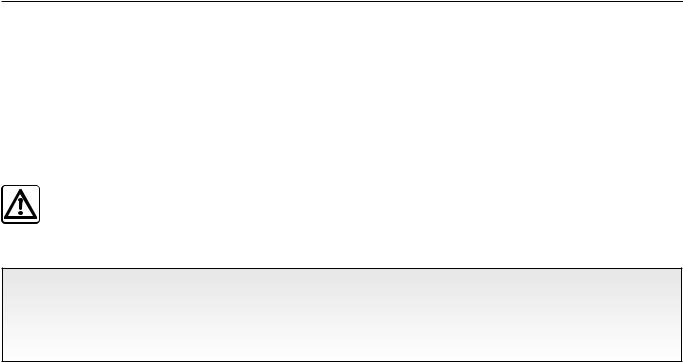
Welcome to your new vehicle
This Driver’s Handbook contains the information necessary:
–for you to familiarise yourself with your vehicle, to use it to its best advantage and to benefit fully from the all the functions and the technical developments it incorporates.
–to ensure that it always gives the best performance by following the simple, but comprehensive advice concerning regular maintenance.
–to enable you to deal quickly with minor faults not requiring specialist attention.
It is well worth taking a few minutes to read this handbook to familiarise yourself with the information and guidelines it contains about the vehicle and its functions and new features. If certain points are still unclear, our Network technicians will be only too pleased to provide you with any additional information.
The following symbol will help you when reading this handbook:
To indicate a hazard, danger or safety recommendation.
The descriptions of the models given in this handbook are based on the technical specifications at the time of writing. This handbook covers all items of equipment (both standard and optional) available for these models but whether or not these are fitted to the vehicle depends on the version, options selected and the country where the vehicle is sold.
This handbook may also contain information about items of equipment to be introduced later in the model year.
Enjoy driving your new vehicle.
Copying or translation, in part or in full, is forbidden unless prior written permission has been obtained from RENAULT, 92 100 Billancourt 2007.
0.1
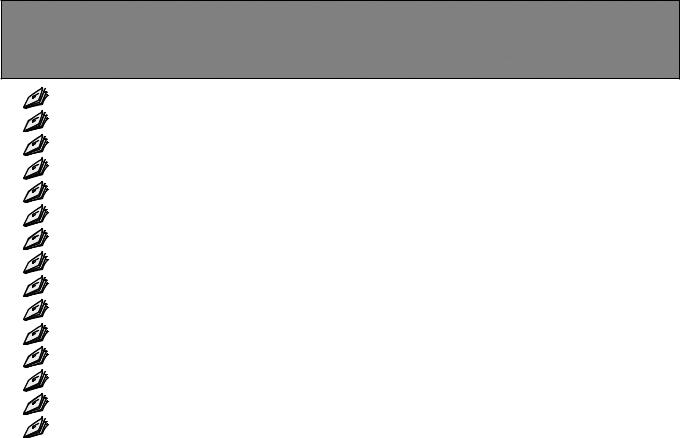
Quick overview
– |
Tyre pressure. . . . . . . . . . . . . |
. . . . . |
. . . . . . . |
. . 0.4 → 0.5 |
|
– |
RENAULT card: use. . . . . . . . |
. . . . . |
. . . . . . . . |
. 1.2 – 1.08 |
|
– |
Child restraint/seat. . . . . . . . . |
. . . . . |
. . . . . . . |
1.29 |
→ 1.39 |
– Warning lights (instrument panel). . . |
. . . . . . . . . . . . . . . 1.44 → 1.58 |
||||
– |
Starting/stopping the engine. . |
. . . . . |
. . . . . . . . . . . 2.3 → 2.5 |
||
– |
Driving . . . . . . . . . . . . . . . . . . |
. . . . . . . . . . . . . |
2.2 |
→ 2.36 |
|
|
Tyre pressure monitor. . . . . . . |
. . . . . |
. . . . . . . . . . . . . . . . . . . . . . . . . . |
2.15 |
→ 2.18 |
|
Electronic Stability Program: ESP . . |
. . . . . . . . . . . . . . . . 2.19 |
|||
|
Traction control: ASR. . . . . . . |
. . . . . |
. . . . . . . . |
2.20 – 2.21 |
|
|
Emergency brake assist. . . . . |
. . . . . |
. . . . . . . . . . . |
. . 2.24 |
|
|
Cruise control/speed limiter. . |
. . . . . |
. . . . . . . . . . . 2.25 → 2.31 |
||
– |
Retractable glass roof. . . . . . . |
. . . . . |
. . . . . . . . . . . . . . . . . . . . . . . . . . . |
. . 3.2 – 3.7 |
|
– |
Heating/air conditioning. . . . . |
. . . . . |
. . . . . . . . 3.8 → 3.22 |
||
– |
Bonnet/maintenance. . . . . . . . |
. . . . . |
. . . . . . . . . . . . . . . . . . . . . . . . . . . |
4.2 |
→ 4.14 |
– |
Practical advice (changing a bulb, fuse, troubleshooting, |
|
|
||
|
operating faults). . . . . . . . . . . |
. . . . . |
. . . . . . . . |
5.2 |
→ 5.38 |
0.2
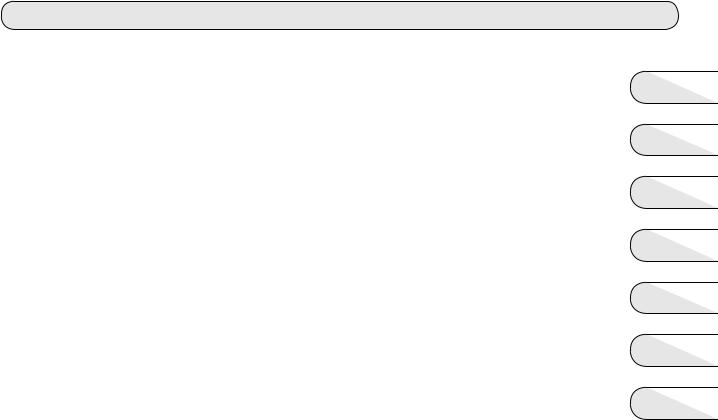
C O N T E N T S
Sections
Getting to know your vehicle ...............................
Driving ...................................................................
Your comfort .........................................................
Maintenance ..........................................................
Practical advice .....................................................
Technical specifications ......................................
Alphabetical index ................................................
1
2
3
4
5
6
7
0.3
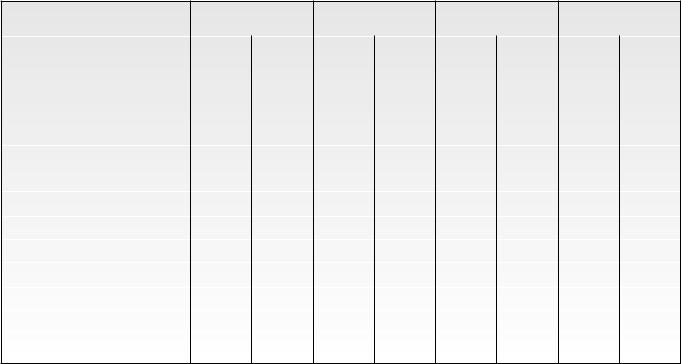
Tyre pressures (in bar when cold)
Versions |
1.6 16V – 1.5 dCi |
2.0 16V – 2.0 T |
1.9 dCi |
2.0 dCi |
|||||
|
|
|
|
|
|
|
|
|
|
Tyre dimensions |
195/65 |
205/50 |
205/55 |
205/50 |
195/65 |
205/50 |
205/55 |
205/50 |
|
|
|
R15 H |
R17 V |
R16 H |
R17 V |
R15 H |
R17 V |
R16 V |
R17 V |
|
|
205/55 |
|
205/55 |
|
205/55 |
|
|
|
|
|
|
R16 V |
|
|
|
|
||
|
|
R16 H |
|
|
R16 H |
|
|
|
|
|
|
|
|
|
|
|
|
||
|
|
205/55 |
|
|
|
205/55 |
|
|
|
|
|
R16 V |
|
|
|
R16 V |
|
|
|
|
|
|
|
|
|
|
|
|
|
Wheel sizes |
6.5 J 15 |
6.5 J 17 |
6.5 J 15 |
6.5 J 17 |
6.5 J 15 |
6.5 J 17 |
6.5 J 16 |
6.5 J 17 |
|
|
|
6.5 J 16 |
|
6.5 J 16 |
|
6.5 J 16 |
|
|
|
|
|
|
|
|
|
|
|
|
|
Non-motorway use |
|
|
|
|
|
|
|
|
|
– |
Front |
2.2 |
2.2 |
2.2 |
2.3 |
2.2 |
2.4 |
2.4 |
2.6 |
– |
Rear |
2.2 |
2.2 |
2.2 |
2.2 |
2.2 |
2.2 |
2.2 |
2.2 |
|
|
|
|
|
|
|
|
|
|
Motorway use (1) |
|
|
|
|
|
|
|
|
|
– |
Front |
2.3 |
2.4 |
2.4 |
2.5 |
2.4 |
2.6 |
2.6 |
2.8 |
– |
Rear |
2.2 |
2.2 |
2.2 |
2.2 |
2.2 |
2.2 |
2.2 |
2.2 |
|
|
|
|
|
|
|
|
|
|
Emergency spare wheel |
2.3 |
2.4 |
2.4 |
2.5 |
2.4 |
2.6 |
2.6 |
2.8 |
|
Tyre safety and use of snow chains
Refer to the information on Tyres in Section 5 for the servicing conditions and. depending on the version. the use of chains.
(1) Special note for vehicles used fully laden (Maximum Permissible All-up Weight) and towing a trailer. The maximum speed must be limited to 60 mph (100 km/h) and the tyre pressure increased by 0.2 bar. Refer to the information on Weights in Section 6.
0.4

Tyre pressure (in psi when cold)
Versions |
1.6 16V – 1.5 dCi |
2.0 16V – 2.0 T |
1.9 dCi |
2.0 dCi |
|||||
|
|
|
|
|
|
|
|
|
|
Tyre dimensions |
195/65 |
205/50 |
205/55 |
205/50 |
195/65 |
205/50 |
205/55 |
205/50 |
|
|
|
R16 H |
R17 V |
R16 H |
R17 V |
R16 H |
R17 V |
R16 V |
R17 V |
|
|
205/55 |
|
205/55 |
|
205/55 |
|
|
|
|
|
R16 H |
|
R16 V |
|
R16 H |
|
|
|
|
|
205/55 |
|
|
|
205/55 |
|
|
|
|
|
R16 V |
|
|
|
R16 V |
|
|
|
|
|
|
|
|
|
|
|
|
|
Wheel sizes |
6.5 J 15 |
6.5 J 17 |
6.5 J 15 |
6.5 J 17 |
6.5 J 15 |
6.5 J 17 |
6.5 J 16 |
6.5 J 17 |
|
|
|
6.5 J 16 |
|
6.5 J 16 |
|
6.5 J 16 |
|
|
|
|
|
|
|
|
|
|
|
|
|
Non-motorway use |
|
|
|
|
|
|
|
|
|
– |
Front |
32 |
32 |
32 |
33 |
32 |
35 |
35 |
38 |
– |
Rear |
32 |
32 |
32 |
32 |
32 |
32 |
32 |
32 |
|
|
|
|
|
|
|
|
|
|
Motorway use (1) |
|
|
|
|
|
|
|
|
|
– |
Front |
33 |
35 |
35 |
36 |
35 |
38 |
38 |
40 |
– |
Rear |
32 |
32 |
32 |
32 |
32 |
32 |
32 |
32 |
|
|
|
|
|
|
|
|
|
|
Emergency spare wheel |
33 |
35 |
35 |
36 |
35 |
38 |
38 |
40 |
|
|
|
|
|
|
|
|
|
|
|
Tyre safety and use of snow chains
Refer to the information on Tyres in Section 5 for the servicing conditions and. depending on the version. the use of chains.
(1) Special note for vehicles used fully laden (Maximum Permissible All-up Weight) and towing a trailer. The maximum speed must be limited to 60 mph (100 km/h) and the tyre pressure increased by 3 PSI. Refer to the information on “Weights” in Section 6.
0.5
0.6

Section 1: Getting to know your vehicle
RENAULT cards: general information, use, deadlocking . . . . . . . . . . . . . . . |
. . . |
1.2 |
|||
Doors. . . . . . . . . . . . . . . . . . |
. . . . . . . . . . . . . . . . . . |
|
1.9 |
||
RAID (Renault Anti-Intruder Device). |
. . . . |
. . . . . . . . . . . . . . . . . . . . . . . . . |
1.13 |
||
Engine immobiliser . . . . . . . |
. . . . . . . |
. . . . |
. . . . . . . |
. . . . . . . . . . . |
1.14 |
Headrests/seat . . . . . . . . . . |
. . . . . . . |
. . . . . . . . . . . |
. . . . . . . . |
1.15 |
|
Seat belts. . . . . . . . . . . . . . . |
. . . . . . |
. . . . |
. . . . . . . . . . . . . . . . . . . . . . . . . . . |
. . . . . . . . . . . . . . . . . . |
1.18 |
Additional devices. . . . . . . . |
. . . . . . . |
. . . . . . . . . . . |
. . . . . . . . . . |
1.21 |
|
to the front seat belts. |
. . . . . . . |
. . . . |
. . . . . . . |
. . . . . . . . . . . . . . . . . |
1.21 |
to the rear seat belts . |
. . . . . . . |
. . . . |
. . . . . . . |
. . . . . . . . . . . . . . . . . |
1.25 |
for side protection. . . . |
. . . . . . . |
. . . . |
. . . . . . . |
. . . . . . . . . . . . . . |
1.26 |
in the event of rolling . |
. . . . . . . |
. . . . |
. . . . . . . |
. . . . . . . . . . . . . . . . . |
1.28 |
Child safety: general information . . . |
. . . . |
. . . . . . . . . . . . . . . . . . . . . . . . . |
1.29 |
||
Choosing a child seat mounting. . . . |
. . . . . . . . . . . . . . . . . . . . . . . . |
1.31 |
|||
Fitting a child seat . . . |
. . . . . . . |
. . . . |
. . . . . . . |
. . . . . . . . . . . . . . . |
1.34 |
Deactivating/activating the front passenger air bag. . . . . . . . . . . . . . . . . . . . |
. . . . . . . . . . . . . . . . . . |
1.37 |
|||
Time and exterior temperature . . . . . |
. . . . |
. . . . . . . . . . . . . . . . . . . . . . . . . |
1.39 |
||
Driving position. . . . . . . . . . |
. . . . . . . |
. . . . . . . . . . . |
. . . . . . . . |
1.40 |
|
Control instruments. . . . . . . |
. . . . . . . |
. . . . |
. . . . . . . |
. . . . . . . . . . . |
1.44 |
Trip computer and warning system . |
. . . . . . . . . . . . . . . . . . . . . . . . |
1.49 |
|||
Steering wheel. . . . . . . . . . . |
. . . . . . . |
. . . . . . . . . . . |
. . . . . . . |
1.59 |
|
Power-assisted steering . . . |
. . . . . . . |
. . . . |
. . . . . . . |
. . . . . . . . . . . . . . . |
1.59 |
Rear view mirrors . . . . . . . . |
. . . . . . . |
. . . . . . . . . . . |
. . . . . . . . . . |
1.60 |
|
Audible and visual signals. . |
. . . . . . . |
. . . . |
. . . . . . . |
. . . . . . . . . . . . . . . . |
1.61 |
Exterior lighting and signals. |
. . . . . . . |
. . . . |
. . . . . . . . . . . . . . . . . . . . . . . . . . |
. . . . . . . . . . . . . . . . . . |
1.62 |
Headlight beam adjustment. |
. . . . . . . |
. . . . |
. . . . . . . |
. . . . . . . . . . . . . . . . . |
1.65 |
Windscreen wash/wipe. . . . |
. . . . . . . |
. . . . |
. . . . . . . |
. . . . . . . . . . . . . . |
1.66 |
Fuel tank. . . . . . . . . . . . . . . |
. . . . . . . . . . . . . . . . . . |
. . . |
1.68 |
||
1.1
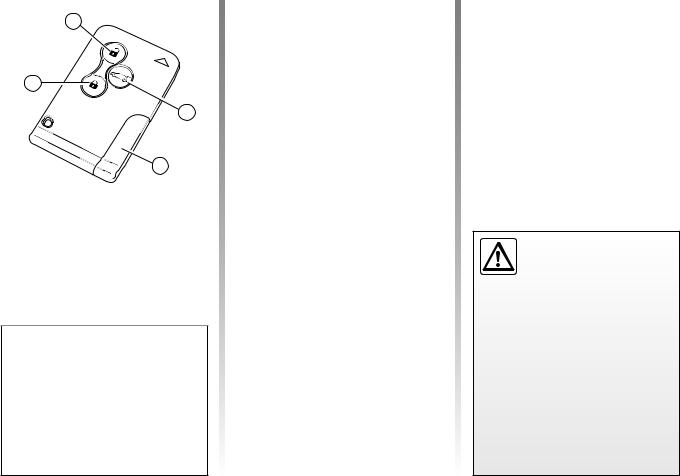
RENAULT cards: general information
1 |
24088 |
2 |
3 |
4 |
1 Unlocking the doors and luggage compartment lid.
2Locking all doors and luggage compartment lid.
3Locking/unlocking the luggage compartment lid.
4Integrated emergency key.
Advice
Do not keep the RENAULT card in a place where it could be bent or damaged accidentally, such as in a back pocket of a garment.
The RENAULT card is used for:
–locking/unlocking the doors and luggage compartment (doors, luggage compartment) and the fuel filler flap (see the following pages);
–automatic closing of windows and sunroof, (depending on the vehicle) refer to the information on “Onetouch electric windows: remote control closing” and “Electric sunroof: remote control closing” in Section 3;
–starting the engine; refer to the information on “Starting the engine” in Section 2.
Battery life
It is supplied by a battery which should be replaced when the message “Change card battery” appears on the instrument panel (refer to the information on the “RENAULT card: Battery” in Section 5).
Range of the RENAULT card
This varies according to the environment. It is therefore important to make sure when handling the RENAULT card that you do not lock or unlock the doors by inadvertently pressing the buttons.
Driver’s responsibility
Never leave your vehicle with the RENAULT card inside and never leave a
child (or a pet) unsupervised. With the card in the reader, it would be possible to start the engine or operate electrical equipment such as the electric windows, and there is a risk that they may trap part of their body (neck, arms, hands, etc.).
Risk of serious injury.
1.2
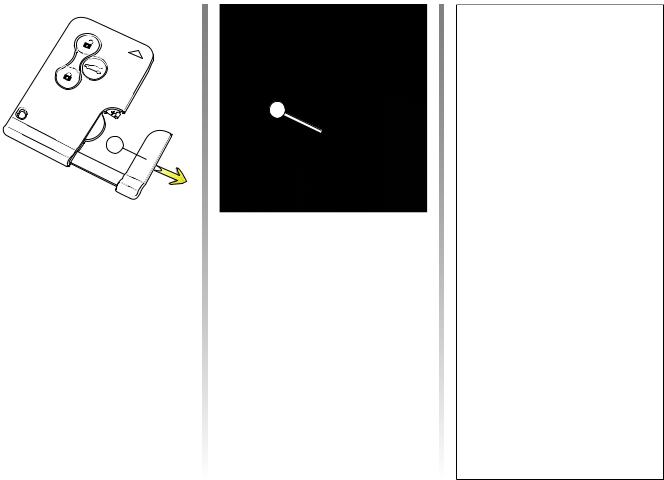
RENAULT cards: general information (continued)
24089

 5 4
5 4
Integrated 4 or separate 5 emergency key
(depending on vehicle)
It is only used in exceptional circumstances, it locks or unlocks the front left-hand door and the luggage compartment lid if the RENAULT Card does not work:
–if the vehicle is located in a zone of high electromagnetic radiation;
–use of devices using the same frequency as the card;
–when the RENAULT card battery is drained, discharged battery, etc.
For instructions on how to use the emergency key, refer to the information on “Locking/unlocking the doors”.
Having entered the vehicle using the emergency key, insert the RENAULT Card in the card reader in order to be able to start the engine.
Replacement: need for an additional RENAULT Card
If you lose your RENAULT card or require another, you can obtain one from your RENAULT Dealer.
If a RENAULT card is replaced, it will be necessary to take the vehicle and all RENAULT cards to your RENAULT Dealer to initialise the system.
You can use up to four RENAULT cards per vehicle.
Faulty RENAULT card.
Make sure that the correct battery type is being used, and that the battery is in good condition and inserted correctly. Their service life is approximately two years.
Refer to the information on the “RENAULT card: Batteries” in Section 5.
1.3
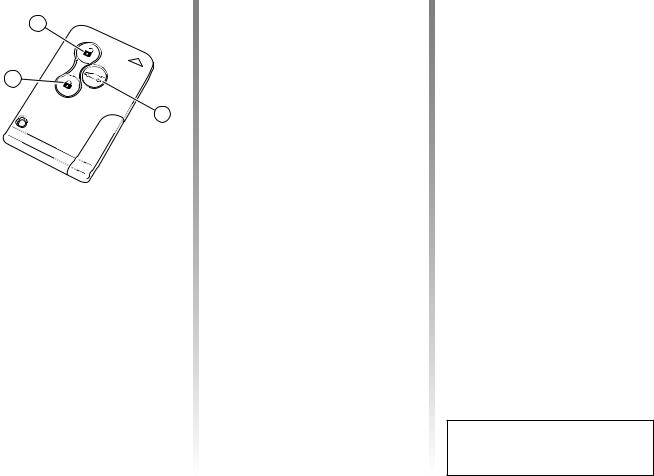
Remote control RENAULT card: use
1 |
24088 |
|
2 |
3 |
Unlocking the doors
Press an unlocking button 1.
The hazard warning lights and side mounted indicators flash once to indicate unlocking.
Special notes (for some countries):
–pressing button 1 enables the driver’s door only to be unlocked,
–the other doors can be unlocked by pressing button 1 twice.
Locking the doors
Press the locking button 2.
The hazard warning lights and indicators lights flash twice to indicate that the doors have locked. If a door or the luggage compartment is open or not properly shut, or if a RENAULT card is still in the reader, the doors and luggage compartment lock then quickly unlock and the hazard warning lights and side indicators do not flash.
Unlocking/locking the luggage compartment lid only
Press button 3 to unlock or lock the luggage compartment lid.
The hazard warning lights and indicator lights flash once to indicate that the luggage compartment lid is unlocked if the vehicle doors are locked.
The hazard warning lights and indicator lights flash twice to indicate that the luggage compartment lid is locked if the vehicle doors are locked.
The card buttons are deactivated when the engine is running.
1.4
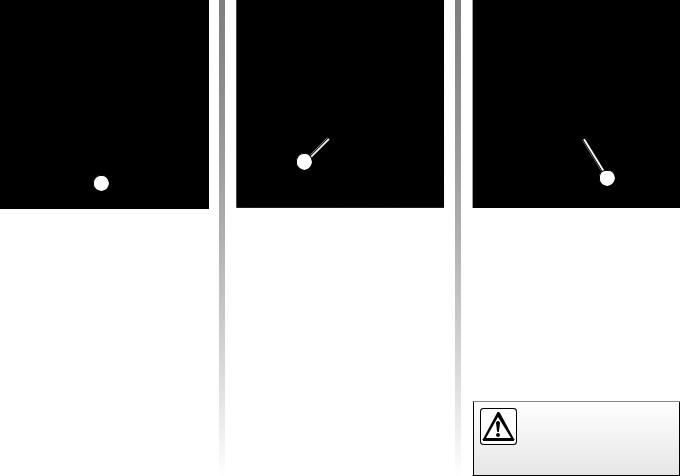
RENAULT card in hands-free mode: use
1
RENAULT card in hands-free mode
In addition to the RENAULT card remote functions, this enables the following to be carried out without touching the key card:
–the opening elements (doors, luggage compartment lid and fuel filler
flap) to be unlocked/locked if the card is within access zone 1;
–starting the engine when the card is inside the passenger compartment (refer to the information on Starting the engine in Section 2).
2 |
Unlocking the doors and luggage compartment lid
Walk up to your vehicle carrying your RENAULT card.
As soon as you place your hand on a door handle 2, the vehicle will unlock. When you press button 3, only the luggage compartment lid will unlock.
The hazard warning lights and indicator lights flash once to indicate unlocking.
3 |
Never leave your vehicle with the RENAULT card inside.
1.5

RENAULT card in hands-free mode: use (continued)
2 |
4 |
Locking the doors and luggage compartment lid
Holding the RENAULT card and with the doors and luggage compartment lid closed, press button 4 located on one of the handles 2 or button 5 on the luggage compartment lid.
The hazard warning lights and indicators lights flash twice to indicate that the doors have locked.
Note: the RENAULT card must be within the vehicle’s access zone to be able to use the buttons for locking.
5 |
If a door or the luggage compartment lid is open or not properly shut, or if a card is in the reader, the doors or luggage compartment lid lock then quickly unlock and the hazard warning lights and indicator lights do not flash.
If you wish to check that the doors are locked after locking with the RENAULT card or the buttons 4 or 5 on the handles, you have approximately three seconds to try the door handles without unlocking them.
After this delay, the hands-free mode is activated once again and any movement of the handle will unlock the doors.
Driver’s responsibility
Never leave your vehicle with the RENAULT card inside and never leave a
child (or a pet) unsupervised. There is a risk that they could start the engine or operate electrical equipment (electric windows) and trap part of their body (neck, arms, hands, etc.).
Risk of serious injury.
1.6
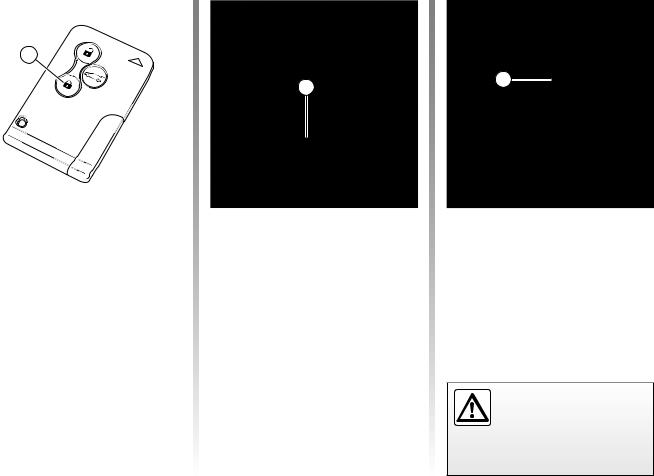
Deadlocking
1 |
24088
2 |
3 |
|
Deadlocking of the opening elements
(for some countries)
This allows you to lock the opening elements (doors, luggage compartment and, depending on the vehicle, the passenger side storage compartment) and to prevent the doors from being unlocked using the interior handles (for example, by breaking the window and then trying to open the door from the inside).
To activate deadlocking, you can:
–either press button 1 twice in quick succession.
–or press the exterior door handle buttons 2 or the luggage compartment logo 3 twice in quick succession.
The hazard warning lights flash five times to indicate locking.
Never use deadlocking if someone is still inside the vehicle.
1.7
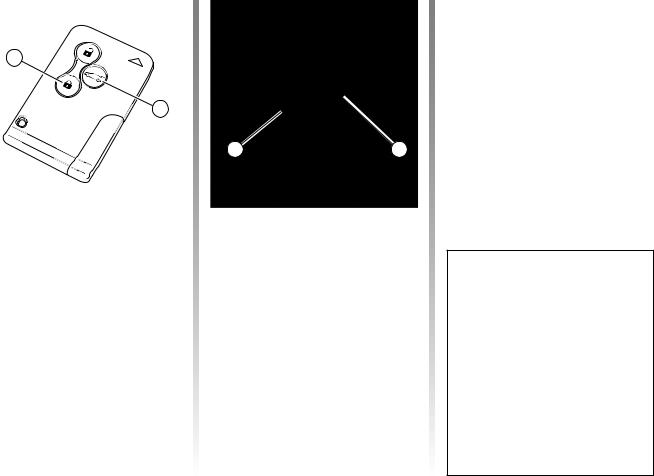
RENAULT card in restricted mode
24088
1 |
2 |
3 |
4 |
Using the RENAULT Card in restricted mode
(depending on vehicle)
In certain situations (vehicle in the hands of a third party: parking valet, mechanic, etc.) you may wish to restrict the operation of the RENAULT card.
When the RENAULT card is in restricted mode it will only permit locking/unlocking of the driver’s door and the fuel filler flap and starting of the engine (the storage compartment on the passenger side and the luggage compartment lid remain locked).
Obtain two cards. Insert a card in the reader 3 then press buttons 1 and 2 on the second card simultaneously. The vehicle will be locked then the driver’s door will be unlocked.
The RENAULT card inserted in the card reader switches to restricted use.
To cancel restricted mode, start the vehicle with the RENAULT card in nonrestricted mode.
Interior locking/unlocking switch 4 is deactivated while the vehicle is used with the RENAULT card in restricted mode.
It is only possible to restrict the use of one RENAULT card at a time.
When using a RENAULT card in restricted use mode, the second card retains all its functions.
1.8

Opening and closing the doors
3 |
2 |
1 |
Opening the doors from the outside
With the vehicle unlocked or the RENAULT hands-free card on you, pull handle 1.
Opening from the inside
Pull the handle 2.
Lights-on reminder buzzer
If you have switched off the ignition and left the lights switched on, a reminder buzzer will sound when a door is opened.
Card reminder buzzer
A beep will let you know if you have left the card in the reader when you open the driver’s door, and the “Remove card” message will appear on the instrument panel.
Special note
After switching off the engine, the lights and any accessories that are in operation (radio, air conditioning, etc.) will continue to operate.
They stop as soon as the driver’s door is opened.
Door/luggage compartment lid open buzzer
If an opening element (door or boot) is open or not properly closed, the message “door open” or “boot open” (depending on the opening element) will appear on the instrument panel as soon as the vehicle reaches 6 mph (10 km/h) along with warning light 3.
1.9
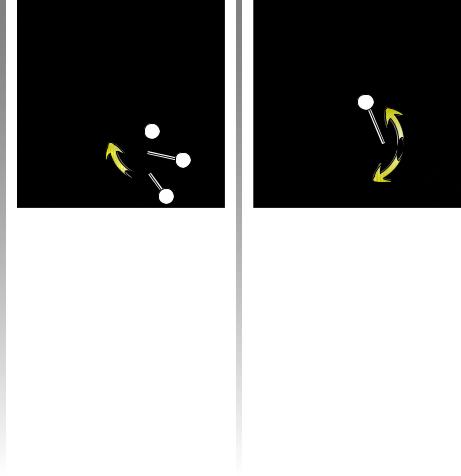
LOCKING/UNLOCKING THE DOORS
Locking/unlocking the doors from the outside
This is done using the RENAULT card: refer to the information on RENAULT cards in Section 1.
In certain cases, the RENAULT card may not work:
–if the vehicle is located in a zone of high electromagnetic radiation;
–use of appliances operating on the same frequency as the card (mobile phone, etc.);
–when the RENAULT card battery is drained, flat battery, etc.
It is then possible:
–to use the emergency key (integrated into the card or, depending on the vehicle, separate) in the front left-hand door;
–to manually lock each of the doors (see the following page);
–to use the interior door locking/unlocking switch (refer to the following pages).
A
1 |
2 |
Using the emergency key 2 integrated to the RENAULT card
Remove cover A from the left-hand door (using the end of the emergency key) in notch 1.
Move it upwards to remove cover A.
2 |
Insert the key 2 into the lock of the front left-hand door and lock or unlock.
1.10
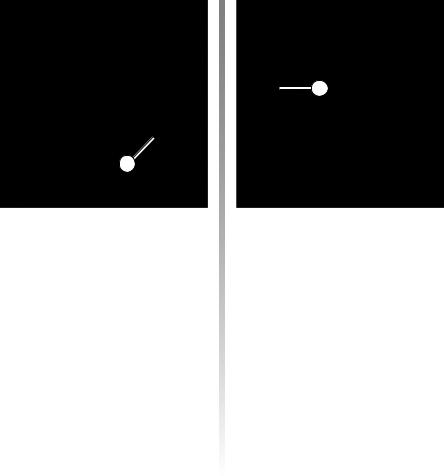
Locking/unlocking the doors (continued)
3 |
Use of the separate emergency key 3
(depending on vehicle)
Insert key 3 into the lock of the left-hand door and lock or unlock the door.
4 |
Locking the doors manually
Turn screw 4 with the door open (using the end of the emergency key) and close the door.
This means that the doors are then locked from the outside.
The doors may then only be opened from the inside or by using the key in the front left-hand door.
1.11
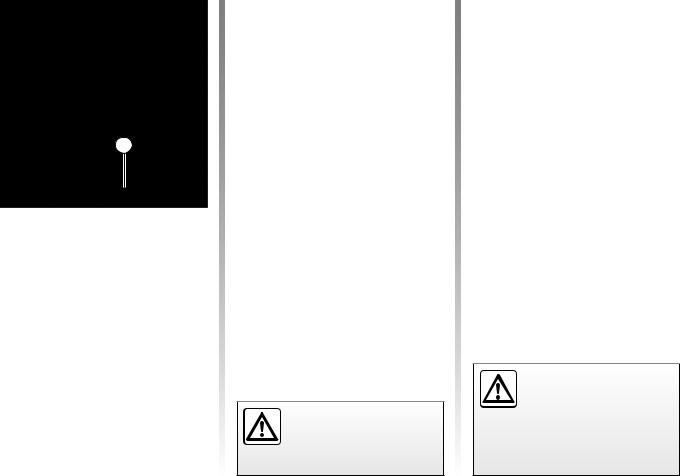
Locking/unlocking the doors (continued)
5 |
Control for locking and unlocking from the inside
The switch 5 simultaneously controls the doors, luggage compartment lid, fuel filler flap and, depending on the vehicle, the passenger side storage compartment
If a door or the luggage compartment lid is open or not closed properly, the doors and luggage compartment lid lock/unlock quickly.
If transporting an object with a door/luggage compartment lid open: with the engine stopped, press the switch 5 for more than five seconds to lock the other opening elements.
Locking the doors and luggage compartment lid without the RENAULT card
(if the RENAULT card is not working, for example)
With the engine switched off and a door open, press and hold down switch 5 for more than five seconds.
When the door is closed, all the doors and luggage compartment lid will be locked.
Unlocking the vehicle from the outside will only be possible with the RENAULT card.
Never leave your vehicle with the RENAULT card inside.
Doors and luggage compartment lid status indicator
When the ignition is switched on, the indicator light integrated in the switch informs you of the status of the doors and luggage compartment lid:
–light on, the opening elements are locked,
–light off, the opening elements are unlocked.
When you lock the doors, the indicator light remains lit for approximately one minute then goes out.
If you decide to keep the doors locked when you are driving, remember that it may be more difficult for
those assisting you to gain access to the passenger compartment in the event of an emergency.
1.12
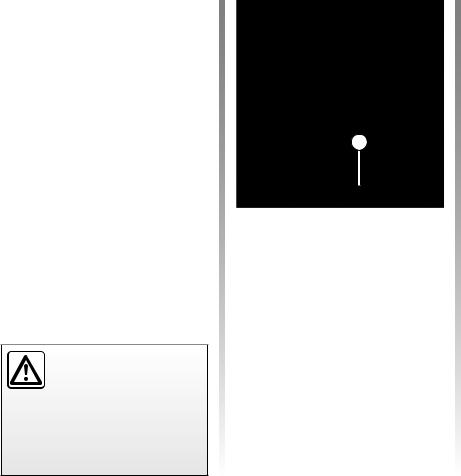
Automatic locking when driving
You must first decide if you want to activate this function.
To activate
With the ignition on, press the central door locking button 1 for approximately five seconds, until you hear a beep.
To deactivate |
|
With the ignition on, press the central |
1 |
door locking button 1 for approximately |
|
five seconds, until you hear a beep. |
|
If you decide to keep the doors locked when you are driving, remember that it may be more difficult for
those assisting you to gain access to the passenger compartment in the event of an emergency.
Operating principle
When the vehicle is started, the system automatically locks the doors when you are driving at about 6 mph (10 km/h) and over.
The door can be unlocked:
–by pressing the door unlocking button 1.
–by opening a door when stationary.
Note: if a door is opened, it will lock again automatically when the vehicle reaches a speed of approximately 6 mph (10 km/h).
Operating faults
If you experience an operating fault (no automatic locking, the indicator light incorporated in button 1 does not light up when trying to lock the doors and luggage compartment lid, etc.), firstly check that the doors and luggage compartment lid are properly closed. If they are closed correctly, contact your RENAULT Dealer.
1.13
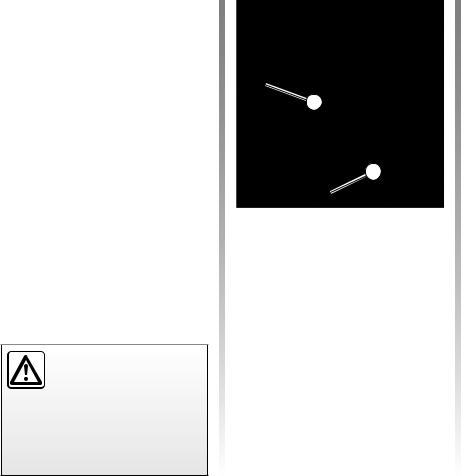
Engine immobiliser
This prevents the vehicle being driven by anyone not in possession of the vehicle’s RENAULT card.
The vehicle is automatically protected a few seconds after the engine is switched off.
Operating principle
ÊWhen the engine is started, warning light 1 remains lit for a
few seconds then goes out (refer to the information on Starting the engine in Section 2).
If the code is not recognised, the card reader flashes rapidly and the vehicle cannot be started.
Any unauthorised work carried out on the engine immobiliser (computers, wiring, etc.) could be dan-
gerous. It must be carried out by a qualified RENAULT technician.
1 |
2 |
Vehicle protection
ÊAfter the engine is switched off, the indicator light flashes
and the vehicle is protected.
Operating faults
ÊIf the warning light continues to flash or remains lit following
an attempt to start the engine, this indicates an operating fault in the system.
If the RENAULT card is faulty (card reader 2 flashing rapidly), use the second RENAULT card, if possible (supplied with the vehicle).
Call your RENAULT Dealer who is the only person capable of repairing the engine immobiliser system.
If there is interference and/or the handsfree RENAULT card is not recognised, insert it in card reader 2.
1.14
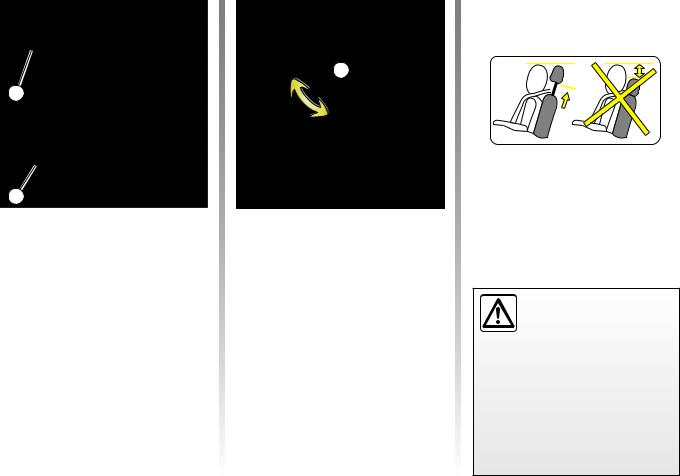
FRONT HEADRESTS
1 |
2 |
To raise it
Pull the headrest towards the front of the vehicle and slide it at the same time.
To lower it
Lift the headrest slightly.
Press control 1 or lift control 2 then lower the headrest to the required height.
To adjust the angle of the headrest
On some vehicles the angle of the headrest can be adjusted. To do this, move the front section A of the headrest forwards or backwards until it feels comfortable.
A
To remove the headrest
First incline the seatback towards the rear.
Raise the headrest until it is at the highest possible setting, press control 1 or lift control 2 then lift the headrest until it is released.
To refit the headrest
Insert the rods into the holes with the notches facing forwards.
Lower the headrest until it locks in position.
The headrest is an important safety component. Ensure that it is in place and in the correct position. The
distance between your head and the headrest should be as small as possible. The top of your head should be in line with the top of the headrest.
1.15

Front seats
1 |
3 |
2 |
To move forwards or backwards
Lift handle 3 to release. Release the handle once the seat is in the correct position and ensure that the seat is fully locked into position.
To tilt the seatback
Lift handle 1 and tilt the seatback to the desired position.
For safety reasons, make these adjustments only when the vehicle is stationary.
To adjust the height of the seat base
Move lever 2 as many times as necessary:
–upwards to raise the seat base,
–downwards to lower the seat.
To avoid hindering the efficient operation of the seat belts, you are advised to keep the seat belt on your
shoulder.
Make sure that the seatback is locked in place correctly.
Nothing should be placed  on the floor (area in front of
on the floor (area in front of  driver) as such objects may slide under the pedal during braking manoeuvres, thus obstruct-
driver) as such objects may slide under the pedal during braking manoeuvres, thus obstruct-
ing its use.
4 |
To adjust the lumbar support on the driver’s seat
Move the control knob 4.
1.16
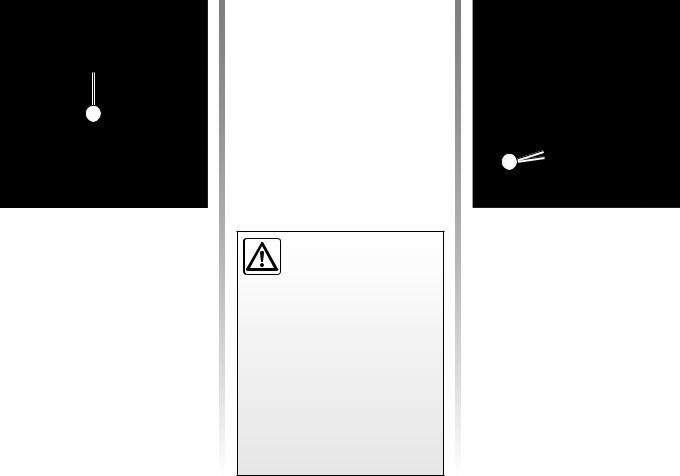
Front seats (continued)
5 |
Access to the rear seats
Lift handle 5 and slide the seat forward.
To return the seat to its original (stored) position on the driver’s side, slide the seat backwards until it locks.
When a person, an object or a child seat prevents the front seats from locking, perform the following operations:
–ask all passengers to leave the vehicle and remove any bulky objects from the rear seats;
–lock the seat(s) in the original position again;
–move the seat(s) forwards to create sufficient space;
–ask the passengers to get back into the vehicle and replace any objects or the child/baby seat on the rear seats.
Check that nothing prevents the front seat from locking. If necessary, remove any
obstructive objects.
Repeat the above until the seat is locked correctly.
Before starting the vehicle and beginning your journey, ensure that the seats are locked correctly.
Risk of seat moving on its runners during vehicle acceleration or braking.
6 |
Heated seats
With the ignition on, press the switch 6 on the centre console or on the side of the seat (door side). The indicator light in the switch comes on.
The system, which has a thermostat, decides whether or not the heating is needed.
1.17
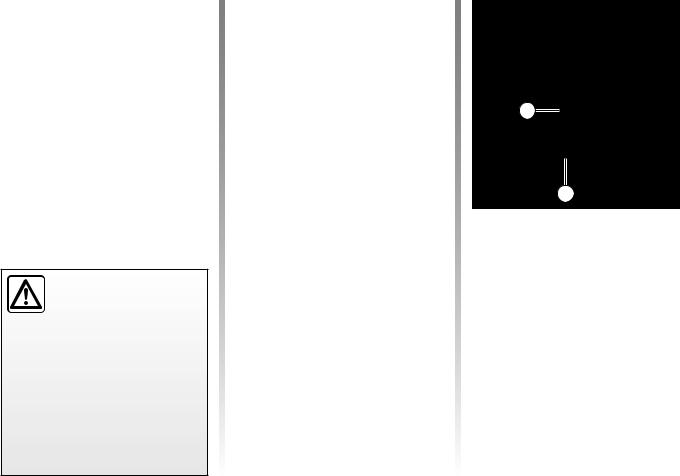
Seat belts
Always wear your seat belt when travelling in your vehicle. You must also comply with the legislation of the particular country you are in.
Before starting the vehicle:
–first ensure that your driving position is correctly adjusted,
–then adjust your seat belt to provide maximum protection.
Incorrectly adjusted seat belts may cause injuries in the event of an accident.
Even pregnant women should wear a seat belt. In this case, ensure that the lap belt is not exerting too much pressure on the abdomen but do not allow any slack.
Adjusting your driving position
–Sit well back in your seat (having first removed your coat or jacket). This is essential to ensure your back is positioned correctly.
–Adjust the distance between the seat and the pedals. Your seat should be as far back as possible while still allowing you to depress the clutch pedal fully. The seatback should be adjusted so that your arms are slightly bent when you hold the steering wheel.
–Adjust the position of your headrest. For safety reasons, the top of the headrest must be level with the top of the head.
–Adjust the height of the seat. This adjustment allows you to select the seat position which offers you the best possible view.
–Adjust the position of the steering
wheel. Refer to the information on the Steering wheel in section 1
1 |
2 |
Adjusting the seat belts
Sit with your back firmly against the seatback.
The shoulder strap 1 should be as close as possible to the base of the neck but not on it.
The lap strap 2 should be worn flat over the thighs and against the pelvis.
The belt should be worn so that it is as close as possible to your body, i.e.: avoid wearing heavy clothing or keeping bulky objects under the belts, etc.
1.18

Seat belts (continued)
1 |
5 |
3 |
4 |
|
||
|
5 |
|
|
|
To fasten
Unwind the belt slowly and smoothly and ensure that buckle 3 locks into catch 5 (Check that it is locked by pulling on buckle 3). If the belt jams before it clicks in, allow it to return before attempting to unwind it again.
If your seat belt becomes completely jammed:
–pull the belt slowly but firmly so that just over 3 cm unwinds;
–then allow the seat belt to rewind automatically;
–unwind it again;
–if there is still a problem, contact your RENAULT Dealer.
ÇDriver’s seat belt reminder and, depending on the
vehicle, front passenger seat belt reminder
If this warning light on the instrument panel or the dashboard goes out, the driver’s seat belt has been correctly fastened.
Unlocking
Press button 4 on the catch 5 and the seat belt will be rewound by the inertia reel.
Guide the buckle to help the operation.
Rear seat belts
The belts are locked and unlocked in the same way as the front seat belts.
1.19

Seat belts (continued)
The following information applies to the vehicle’s front and rear seat belts.
– No modification may be made to the component parts of the restraint system (belts and seats and their mountings) fitted originally.
For special cases (e.g. fitting child seats) contact your RENAULT Dealer.
–Do not use devices which allow any slack in the belts (e.g. clothes pegs, clips, etc.): a seat belt which is worn too loosely may cause injury in the event of an accident.
–Never wear the shoulder strap under your arm or behind your back.
–Never use the same belt for more than one person and never hold a baby or child on your lap with your seat belt around them.
–The belt should never be twisted.
–Following a serious accident, the seat belts in use at the time must be replaced. Always replace your seat belts as soon as they show any signs of wear.
–If necessary, readjust the position and tension of the belt.
–Make sure that the seat belt buckle is inserted into the appropriate catch.
1.20
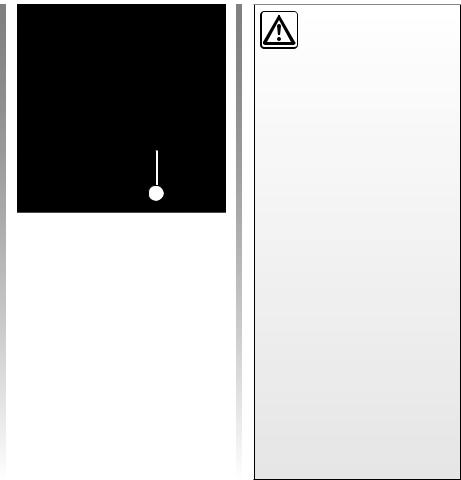
Restraint systems in addition to the front seat belts
Depending on the vehicle, they will consist of:
–buckle pretensioners,
–chest-level load limiters,
–air bags for driver and front passenger,
–anti-submarining air bags.
These systems are designed to act independently or together when the vehicle is subjected to a frontal impact.
Depending on the severity of the impact, the system can trigger:
–seat belt locking,
–the buckle pretensioner (which engages to correct seat belt slack);
–the anti-submarining air bag to keep occupants in their seat, the front low volume air bag and the load limiters;
–the large volume front air bag.
1 |
Pretensioners
The pretensioners hold the seat belt against the body, holding the occupant more securely against the seat, thus increasing the seat belt’s efficiency.
In the event of a severe frontal impact and if the ignition is switched on, the system may engage the following depending on the force of the impact:
–the piston 1 which immediately retracts the seat belt;
–the anti-submarining air bag.
– Have the entire restraint system checked following an accident.
– No operation whatsoever is permitted on any part of the system (pretensioners, air bags, computers, wiring) and the system components must not be reused on any other vehicle, even if identical.
–To avoid incorrect triggering of the system which may cause injury, only qualified RENAULT Network personnel may work on the pretensioner and air bag system.
–The electric trigger system may only be tested by a specially trained technician using special equipment.
–When the vehicle is scrapped, contact your RENAULT Dealer for disposal of the pretensioner and air bag gas generators.
1.21
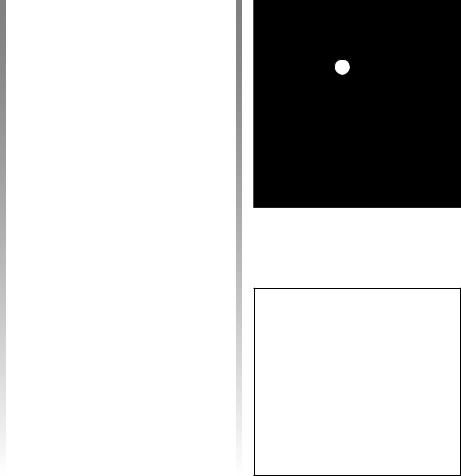
Restraint systems in addition to the front seat belts (continued)
Load limiter
Above a certain severity of impact, this mechanism is used to limit the force of the belt against the body so that it is at an acceptable level.
Air bags for driver and front passenger
Fitted to the driver and passenger side.
The presence of this equipment is indicated by the word “Air bag” on the steering wheel and the dashboard (air bag zone A) and a label on the lower part of the windscreen.
Each air bag system consists of:
–an air bag and gas generator fitted on the steering wheel for the driver and in the dashboard for the front passenger;
–an intelligent computer for both systems, which includes an impact sensor and a monitor controlling the electrical trigger system for the gas generator;
–a single tell-tale light Åon the instrument panel.
A
The air bag system uses pyrotechnic principles. This explains why, when the air bag inflates, it will generate heat, produce smoke (this does not mean that a fire is about to start) and make a noise upon detonation. In a situation where an air bag is required, it will inflate immediately and this may cause some minor, superficial injuries or other problems.
1.22
